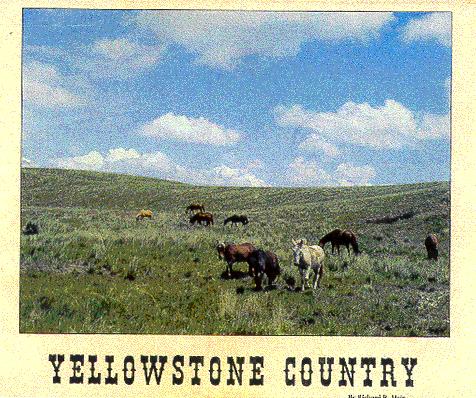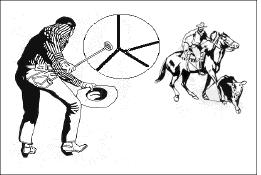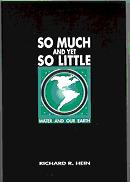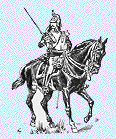MT Home Site
YELLOWSTONE COUNTRY
by Richard R. Hein
Comments by Judy A. Remmick-Hubert, Richard R. Hein's niece.
(1911 - )
"This story covers one hundred years of history plus comments of the time before and after, I will write about fifty years of stories as told to me by the old timers, my grandparents, my parents and friends of the family..... Indian Wars, buffalo hunting, the cattle barons....ranches that had survived the Indians, the droughts, and the killer storms."

Richard wrote: "The Depression was on and I could hire help for a dollar a day and I had two families working for me. I shared my three-room shack with two rooms being occupied by the Crien family. The Brandner family had brought a tent...There were six in the family, all over six feet all. He married Helen. In 1936 he, Helen and their son left Montana for Washington. He sold his property and animals to his brother Oscar. He worked for the Northern Pacific Railroad. WWII occurred and Richard was taken into the army and stationed on an American troop ship. Richard and his family would return to Montana and become cattle ranchers..... His last Montana ranch was in western part of the state which, I believe, was 20 thousand acres... I , his niece, recall his last Montana ranch which had more than cattle. I remember seeing a huge old bear eating berries along the road side as he drove around viewing this marvelous place that was his.... He had timber and a mountain with uranium.... Later, he retired to Oregon, if you call his busy life retirement.
Here is a short list of people he knew and heard first hand stories of famous people and historical events:
(1) Mr. Arthor Parson told Richard how he took President Theodore Roosevelt hunting... p. 170 .... p. 149.... Mr Parson knew Pierre Wibaux and his wife Millie; the Marquis de Mores and his wife Madora..... p. 146. The Parson ranch, established in 1880, became the largest horse ranch in Eastern Motana and Western North Dakota so Mr. Parson had rubbed elbows with the "elogant people".
(2) Richard's uncle Christoph Hein owned a place next to Kid Carson who was a distant relative of Kit Carson...
(3) Mr. Karst had been with Gen. Custer and the troop which died at the Little Big Horn. He had several other fellows had been left with the gattling guns which was slowing down Custer who was anxious to get to Little Big Horn that eventful day.... p. 90 Mr Karst also knew the Sioux called "Wooden Leg" who had been part of the battle against Custor. p. 92 Mr. Karst was part of the burial troop that buried the dead ..p. 97. He, also, knew Kit Carson p. 98
(4) Mr. Henry Bolter, who was an old Buffalo hunter, talked about Mr. Karst who like he had also hunted Buffaloes....Talked about the building of the Northern Pacific railroad..... p. 151
(5) Indians Wars were discussed by the old timers like Mr. Lawrence Heitzman..John Huntan, Mr. Green, Mr. Van Halters ...p. 25
(6) Mr. Charles Krug . who was one of the old ranchers, a good friend to Ludwig Hein, told Richard many stories about what it was like to have been one of the early ranch "barons". He was born in Petersburg, Ohio in 1846. He and his wife Annie settled near Glendive in 1880.. He had about 500 head of cattle by 1885... which he lost in the winter of 1886/7.... In 1887 he came to Cabin Creek which was northwest of where Marsh would be and started a sheep ranch. As he prospered he bought land at 75 cents to $1.75 an acre... Soon he and 54 sections with 800 acres.... He also ran for chairman of the board of County Commissioner and won....The Krugmanion was built in 1906.... It had 29 rooms... He bought into the German-Scandinavian Bank and also the Merchant's Bank.... And so the list continues..
(7) Mr. Dore talked about being at Fort Buford when Sitting Bull was brought in as a prisoner.... p. 118
(8) Richard heard story tellers told him about Pierre Wibaux, Marquis de Mores, Conrad Kohrs, John Clay , Mr. Johnson, Arthur Parson....and others. Some of these men his father had known.... p. 120
(9) Amos James talked about Chief Joseph of the Nez Perce Indians.....and other events that occurred in Washington in the 1860s... Talked about the Oregon trail and the wagon trains...And the famous James Gang and family.... to whom Amos was first cousin.... Also talked about Gen. Grant with whom is brother had fought in Virginia.... Amos' brothers were freighters who hauled fright to the gold fields in Montana...
(10) Lew Ayers talked about the wars between the cattleman and the sheep men... Told about the Parson's Horse Ranch and Poserwville in the old times.... shortage of women, dances, playing poker all night..... terrible winter storms.....about Wild Mustangs......
There were others Richard spoke about in his book but this gives you a slice of Richard R. Hein's life.
"...my Dad had bought the Walking Y Lazy V [brand] from Mr. Robert Olson and it could very well have been one of the older brands in Montana." tells Richard Hein, son of Ludwig Hein.

Richard Hein owns this old brand Walking Y Lazy V, which his father had owned in the early days.
At the Age of 90 Richard Hein has published his second book:
SO MUCH AND YET SO LITTLE,
WATER AND OUR EARTH

"So Much and Yet So Little, by Richard R. Hein, offers an illuminating overview of one of the things that made America great: its natural resources
Water, soil, oil, coal, nuclear power, gas, and forests are discussed in both historical and scientific terms. While the author points out the achievements of the past, he also examines the possibilities of the future. Hope and caution are the watchwords, or should be, as we build our energy policy. Hein does not hesitate to criticize where he feels criticism is due, and environmentalists of the current type come in for a great deal of it.
Whichever position you take, you will find this book a provocative approach to a critical subject.
RICHARD R. HEIN was born in North Dakota. His father, a rancher, soon moved the family to Wyoming where the author grew up. Following his own career in ranching, merchandising, and general contracting, Mr. Hein retired and now lives with his wife, Helen, in Oregon. The couple has two grown children."




